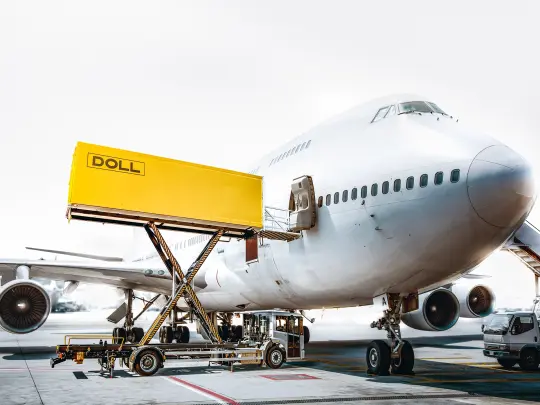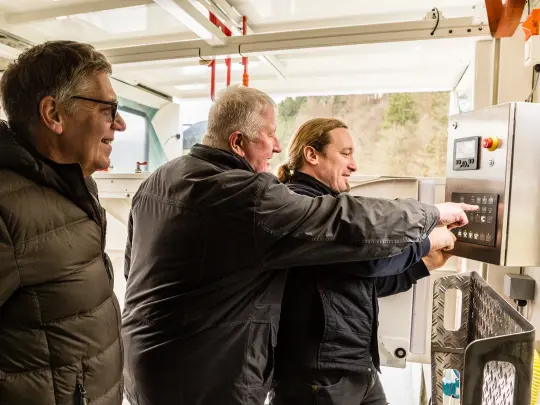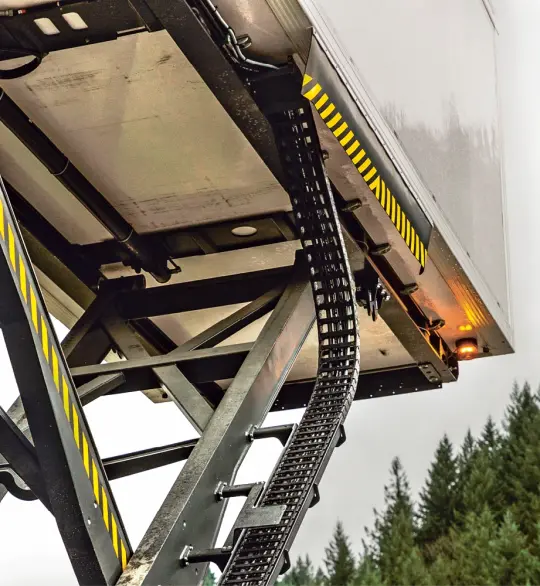Delivery Service on the Tarmac
Gluten-free, vegetarian, kosher, or standard: on every flight, a wide variety of meals land in the flight attendants’ trolleys. They are brought to the aircraft by scissor lift catering trucks from DOLL Fahrzeugbau GmbH.


On the flight from Frankfurt to Madrid, economy class guests are eating their noodles with chicken, while business class travellers enjoy either steak or cod served with potatoes. The fresh meals are supplied by a catering company whose most important helper is a scissor lift catering truck from DOLL.
Uwe Trox, mechatronics manager at DOLL Fahrzeugbau GmbH in Oppenau, near the Black Forest, explains how the meals reach the passengers: “The menus are prepared by the respective catering contractor in a commerical kitchen, often on the airport grounds. Here, all meals are cooked, shrink-wrapped, marked and loaded into the trolleys that are later pushed through the aircraft. This is where our catering truck comes into operation. First it reverses up the loading ramp of the commercial kitchen. Once the vehicle is in position and the internal cooling system has been connected to the mains, catering staff open the roller door and push the trolleys across the loading ramp into the container on the truck.”
When the container is full, the driver makes his way to the waiting aircraft. On arrival, the hydraulic supports of the catering truck are extended. These ensure the truck stays firmly on the ground even during strong gusts of wind. The driver now climbs into the container and is lifted upwards along with all the cargo. When he’s at the correct height beside the aircraft, he puts the ramp and guardrail into the position at the aircraft door.
EXACT DISTANCE
“The vehicle and aircraft must never touch each other,” explains Uwe Trox. “This could lead to damage of the outer layer on modern aircraft with high-tech materials, which would be totally invisible without technical aids. Ultrasonic sensors on DOLL trucks thus ensure that the required distance between the ramp and aircraft is maintained. The front access barrier is not unlocked until this position has been reached. A stable folding plate bridges the remaining gap so the trolleys can be safely rolled in.“Planes only earn money when they’re in the air, which is why loading must be very precise and very quick,” says Michael Harter, electric catering product manager at DOLL. “Disruptions incur high costs.” Afterwards, the container is lowered, the supports are retracted and the catering truck returns to the kitchen where the procedure starts from the beginning again. There’s room for approximately 40 trolleys in the container which must be permanently air-conditioned to ensure the refrigeration is not interrupted. The food isn’t warmed up again until it is on the aircraft. “DOLL vehicles are used by almost all large and important catering companies,” says Trox. “This is because safety regulations are getting stricter at airports around the world, and our technologies are leaders in personnel and material safety.”
READY FOR THE WORLD
Scissor lift catering trucks have been part of the Oppenau-based company's product range for more than 20 years. Initially a niche product alongside timber transport, heavy-load hauling, and military vehicles, the company has been serially manufacturing catering trucks since 2005. In many cases, the customer provides the chassis on which the DOLL lift sits. It sells threetypes: the x-cat M with a half-size cab for small aircraft with a sill height of less than one and a half metres (five feet), the x-cat M with a full-size cab for larger aircraft with a sill height of up to six metres (20feet), and the x-cat L for the world's largest passenger plane, the Airbus A380, which can be raised more than eight metres (26feet). DOLL is one of the few manufacturers worldwide certified to serve the Airbus A380. “The door on the Airbus A380 is on the upper deck above the wing,” explains Michael Harter. “This means that the entire body has to be moved forward three metres (10 feet) at a height greater than eight metres (26 feet). To precisely position the platform at the aircraft door, the operator can laterally extend the platform by up to 60 centimetres (24 inches) and the ramp by a further 110 centimetres (43 inches). ”The large sill height and the sliding of the container required a special support concept. The support cylinders usually extend just half a metre to each side to ensure they are capable of with standing strong gusts of wind. In the USA however, where even stronger air currents must be accounted for, they have to extend a whole metre. For the American market, DOLL supplies kits to Bridgeport, near Philadelphia, where the DOLL America subsidiary builds them onto trucks. DOLL superstructures can be adapted to all common truck chassis, meaning they can also be carried on public roads. “This is important for catering at JFK Airport in New York for example, where the commercial kitchen is 40 miles away,” says Uwe Trox.

DURABLE CABLES
Since 2015, HELUKABEL Megaflex 500 and Multiflex 512 cables as well as two custom HELUKABEL cables have ensured that containers can be moved up, down, back and forth on the catering trucks. It was crucial here to update the controllers in all vehicles from a hard-wired to a programmable logic controller (PLC). “For this, DOLL required hybrid cables capable of transmitting electrical energy and electronic bus signals,” explains Rainer Maier, regional sales manager at HELUKABEL. “So we developed the two custom cables for the catering trucks with modified cross sections and screening as well as twisted pairs for CAN bus transmission. ”The cables have to endure a lot: from resisting de-icing fluids used heavily at airports to UV-radiation. They are also halogen-free to ensure no toxic gases are released in the event of a fire. “In particular for the A380, [the cable’s] compliance with bending radii was a deciding factor,” emphasises Michael Harter. DOLL also places high demands on temperature resistance as the cables have to endure temperatures as low as minus 30 degrees (-22o F). “Our catering trucks are used in all climate zones around the world,” says Uwe Trox. “After all, guests boarding a plane in Siberia also want something tasty to eat.”
SPEEDY DELIVERY
Who: DOLL Fahrzeugbau GmbH, Oppenau, 350 employees
What: Founded in 1878, the company originally manufactured carriages and forestry tools such as axes and machetes before specialising in bodies and trailers for commercial vehicles. Today DOLL is, among other things, active in the fields of timber transport, heavy-load hauling, and airfield support equipment. The vehicle maker has been serially manufacturing scissor lift catering trucks since 2005. DOLL is one of the few manufacturers certified to service the Airbus A380.
